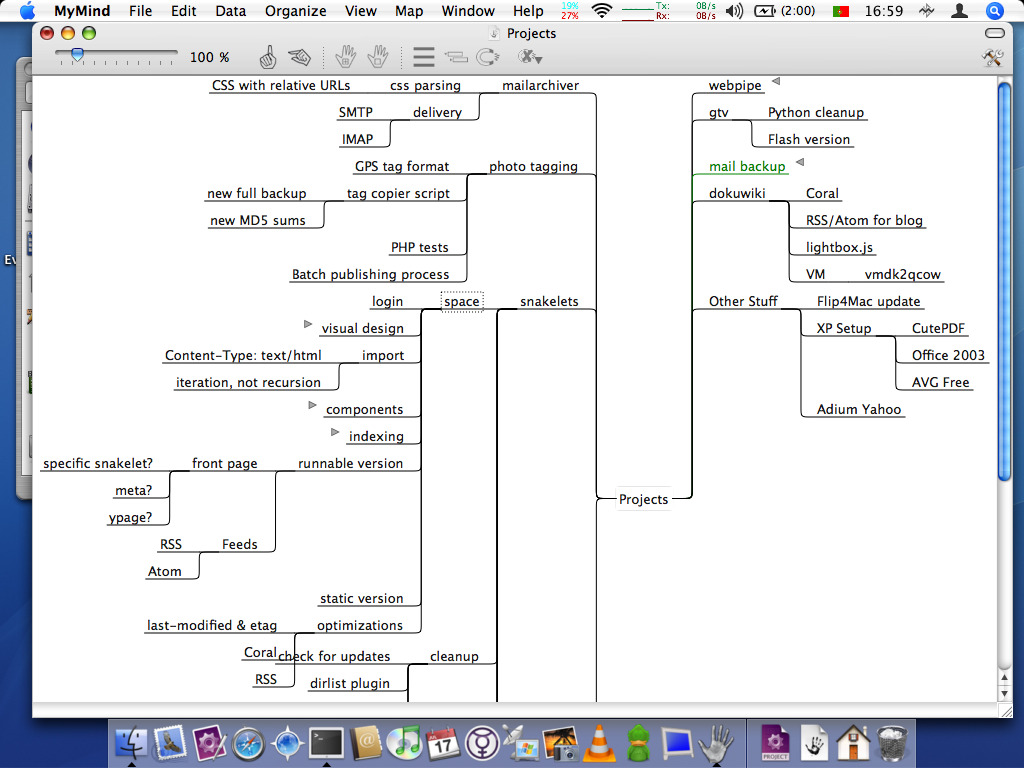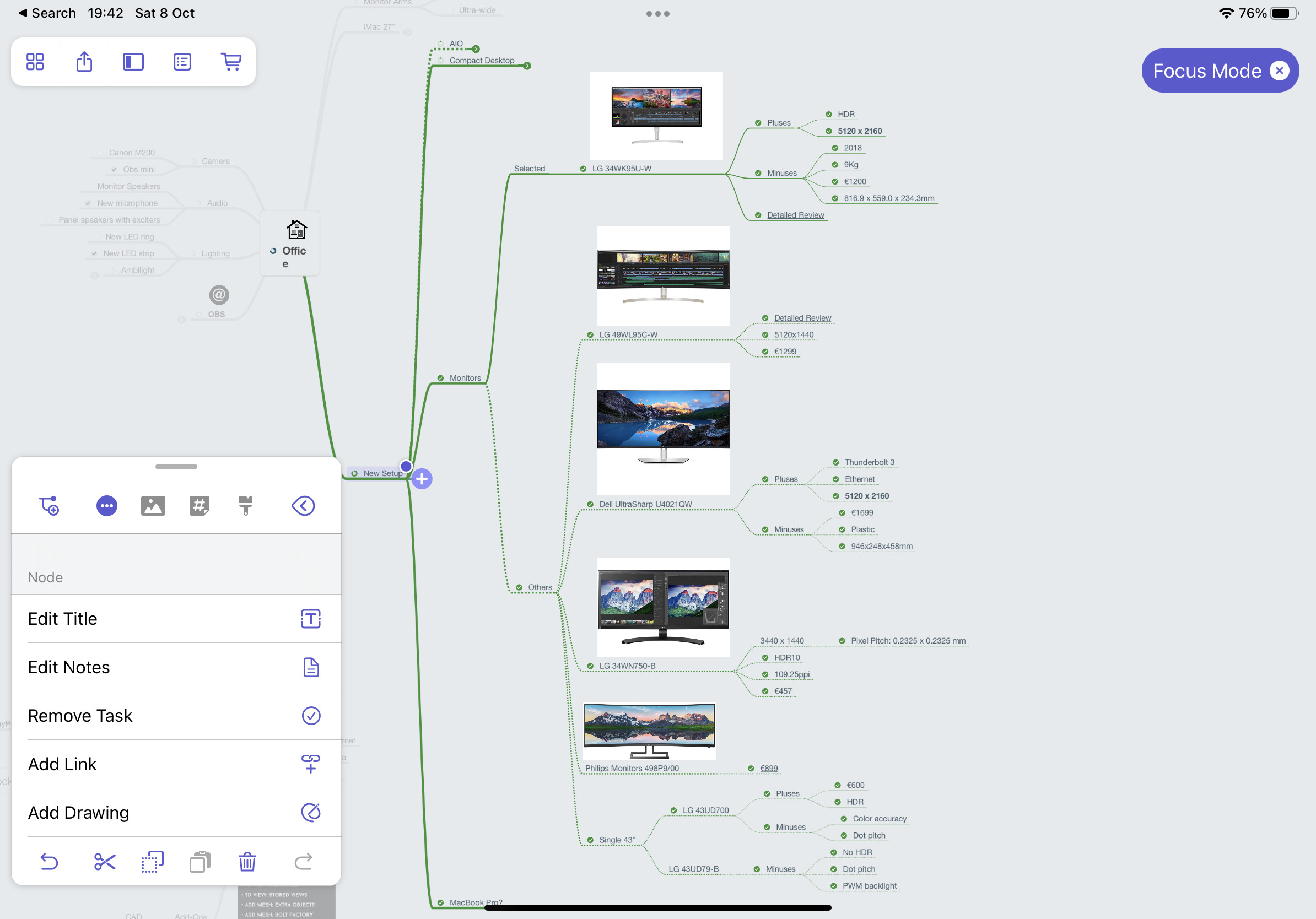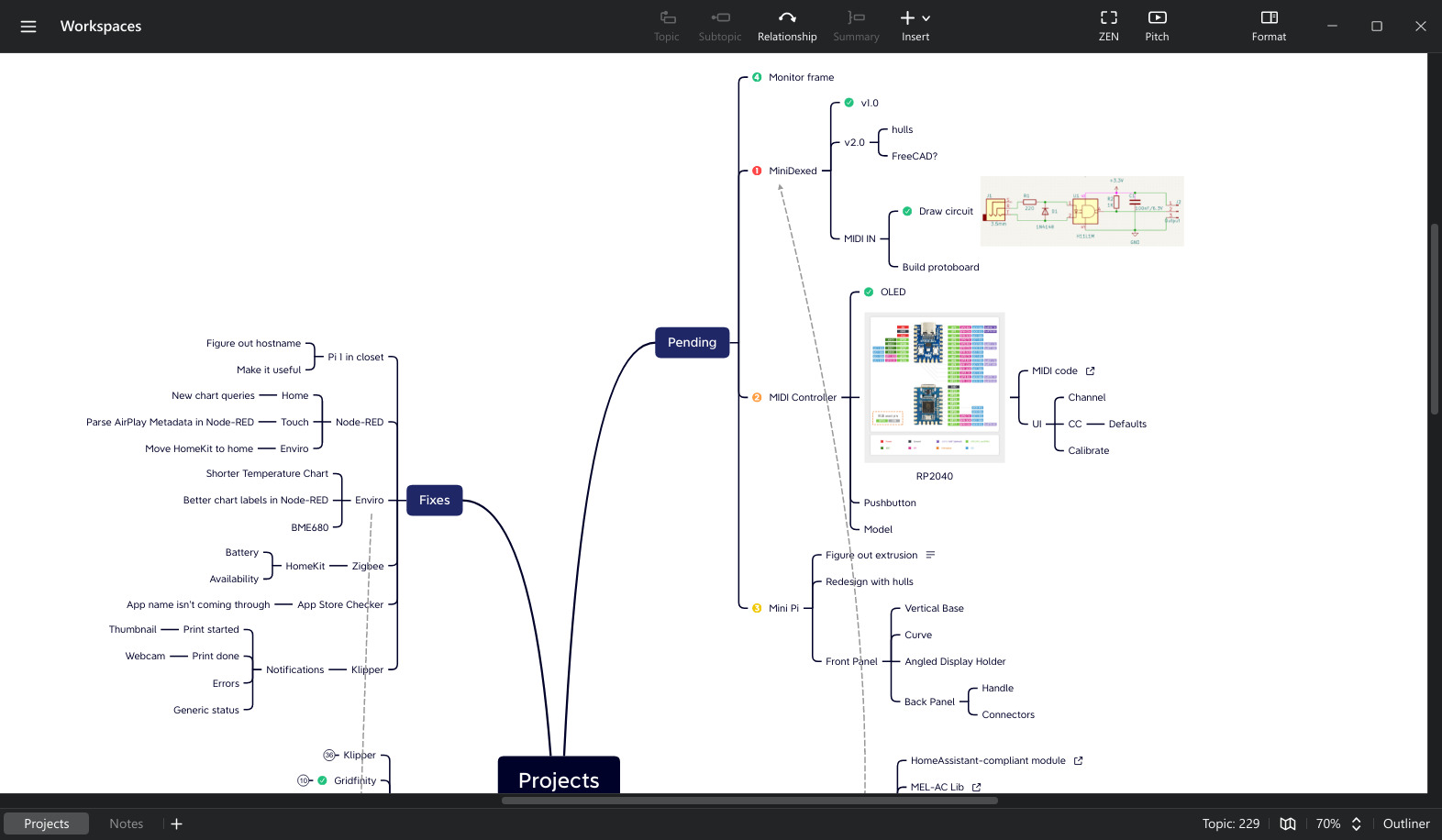I don’t think of myself as particularly organized, but I do like to prioritize and reason things out both visually and conceptually with at least a modicum of order, and over the years the only approach (other than notetaking) that has consistently stuck with me is mind mapping.
Jumping The Queue
First off, and since I make extensive use of mind maps to keep track of activites and task lists, let’s get the “Getting Things Done” elephant out of the room – I find To Do lists, checklists, or any other form of standalone task tracking to be less than useless, since they inevitably turn into a dumping ground of miscellanea, sitting in their little isolated app.
But I tend to be almost obsessively methodical (and depth first) in some things, so I try to capture current state of what I am doing, so that I can get up to speed quickly if I’m interrupted (which I almost always am).
So I usually have tasks in mind maps as part of a context, which means that when I am looking at a task, I usually have all the info required to do it right alongside.
Another thing that really works for me instead of hunting through various project tools (or chat windows, or notes in OneNote, or Kanban boards, or whatever) is just keeping unresolved threads in my inbox, which again provides me with all the context I usually need. Mail may be out of fashion, but flagged messages are still a good blend of To Dos and my documentation.
Then there’s notetaking. Wikis (like this site, and vimwiki for smaller things) have mostly fixed that problem too.
Keeping track of the bigger picture, though, is another matter. For reasoning things out, understanding dependencies and (ultimately) figuring out what what needs to be done, I use mind maps - sometimes for a single project, sometimes for an entire domain of work (or personal interests).
Why Mind Maps?
I like mind maps because they leverage my visual memory in ways no other tool does, and make structure immediately apparent in ways no other organizational tools can in a number of situations: note-taking, planning, and even live discussion.
And that works not just for myself but also when working with others, since the relative positions of nodes can be as informative (and often more memorable) than entire sentences.
In particular, I find that the work of actually mapping out things and their relationships helps me focus on even the dreariest of matters, something that has been extremely useful during the pandemic and various episodes of near-burnout.
There’s a certain sense of accomplishment from visually laying out things, and the spatial relationships really help in terms of recollection and focus.
So I will typically start out building a mind map of the things that I find weird or potentially risky in a particular project, and then, as I build a more structured view of the work itself (which is typically around people, outcomes and timelines) move them into the right places to figure out how to deal with them.
There are many online “solutions” for mind mapping, but I refuse to use any of them since I want to own my data and nearly all of them are woefully limited and kludgey, so for the past few years I’ve been using native apps only, all of which I can get my data out of if needed.
Outlines lack visual hooks, drawing conventional diagrams or drafting conventional notes takes too much focus away from what is going on, and mind maps, with the right tools, are great for quickly sketching out procedures, task lists, and even entire projects.
For me, speed is essential – I often share my screen and build out a mind map while discussing things, annotating it as the meeting progresses.
And the ability to quickly grab an entire tree and move it to a new context trumps building highly complex and organized layouts that are treated like bonsai – so my mind maps tend to be highly asymmetrical affairs, representing projects, decision trees, or just a knowledge domain I’m exploring in a project.
Early Software

I think everyone got started with Freemind, just because it was one of the first half-decent desktop apps and, being Java, ran nearly everywhere.
I did too, back when I was working at Vodafone, and used it for notes (it was reasonably good at that), but today it is an ancient, antiquated piece of software that has been superseded by much better things.
I have always been at odds with the likes of Freemind and Freeplane because despite being free, they are horrendously clunky (not to mention ugly as sin). Freeplane now has a pretty decent extension ecosystem, but it never supported iOS, so I never actually used it for more than a couple of days.
MyMind is gone now, but it was a great altertative on the Mac, and it took years for me to find something I was happy with on Apple platforms.
The Best App – for Apple platforms

Mindnode was a lifeasver in that regard. It is by far the best Apple-native mind mapping tool, has a pretty extensive feature set (I particularly like its Focus Mode) and, on both the Mac and iOS, has a very sane keyboard experience (although the “fold” command is assigned to Alt+., which I find somewhat unintuitive on a Portuguese layout and can never remember).
I am quite sad that Mindnode has moved to a subscription model. I understand the trend, but thoroughly detest it as a user, because it removes any kind of trust I might have in long-term “ownership” of software, even on such a curated platform as iOS. And even though I have been grandfathered into a tier that still provides a good deal of functionality, I refuse to pay subscriptions for every app I use1.
If I have to pay for a subscription, well, I might as well pay for one that covers all the platforms I use, and not just Apple ones.
On Linux
I also briefly explored Minder, older versions of which are available in Ubuntu and Debian repositories (Fedora seems to be the most up to date, but these days most desktop Linux distributions can use flatpak anyway).
Although it lacks a lot of the visual polish of the other ones, it is clearly inspired by XMind (many options are laid out the same way) and supports exporting to multiple file formats, including XMind and Freemind (its native file format is XML-based, so I could rig up a converter, but it’s nice to see the export options).
The Current Winner
Enter XMind, which I had been using on and off to escape Freemind, and which I adopted as my primary tool when Mindnode moved to a subscription model. Because even though I still have many personal mindmaps in Mindnode, I can run XMind on Windows, macOS, iOS and… Linux.
Yes, Linux. I’m using it almost daily in Fedora, and love it:

This, plus a standard file format that is likely to be usable on any platform for many years (instead of Mindnode’s somewhat limited export features) is something I’m willing to pay a subscription for, since there is no way I could get a fully cross-platform, long-term mind map tool otherwise.
So after using XMind 8 for many years on Windows, I’m now using it also on my Mac and iPad for some more serious personal projects (mostly research I have to share with other people, and occasional work drafts I end up doing on the go).
The free edition (including XMind 8, which you can still run on Windows, and which I actually packed into a container using Guacamole) can’t include images and has a few more limitations, but works (and doesn’t have any plugs into their cloud services, which I dont use).
Another reason I prefer XMind these days is that it works like a dream for fast note-taking on the fly–the keyboard commands are intuitive, reasonably consistent across all platforms and very, very smooth2, and I find myself quickly building out and easily reorganizing very large research or reference documents with ease.
And I realize that this is definitely a matter of personal taste, but I actualy prefer XMind’s more sober visuals over Mindnode.
Yes, there is such a thing as “too colorful” – I usually send out PDF versions of my notes, and the stark, black on white, mostly rectilinear output (with rounded corners, but not sweeping curves between nodes) just looks more polished and professional, at least to my eye.
Conclusion
It’s not all roses, though. For some weird reason the desktop apps don’t auto-save, the iOS version has crashed on me a couple of times (no data loss, but… not ideal), and some recent UX changes actually made it less usable3,
But being able to drag and drop documents, links and whatnot into it and quickly sort them out into something that my brain can quickly parse, memorize and locate later (spatial memory is still a thing, even if Apple completely broke it in the modern Finder) is a great thing to enjoy, and that’s not something I can say for most desktop software.
And yes, I am aware there are zillions of crappy web-based mind mapping tools. None of them are of any interest to me whatsoever, thank you very much.
Update: There is another kind of mind mapping tool I’m interested in, which is this one. It horrifies me that it is written in
PHP, but I hope someone will port it to Go or similar in the near future.
-
The saving grace here is that it’s comparatively cheap (at least when compared to XMind and that it can be shared through Family Sharing, but I still prefer not to be nickel and dimed – I bought the full app outright for several versions, and would like to keep doing it. ↩︎
-
Except on Linux, where I have been reporting an extremely irritating bug that creates new nodes when I use the cursor keys for almost a year no, with no resolution in sight. Oh well. ↩︎
-
Yay for cross-platform toolkits, but at least the desktop versions are Java with an embedded JRE and not Electron… ↩︎